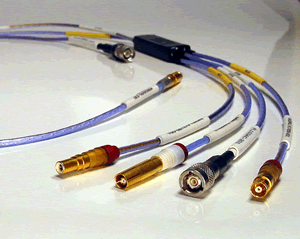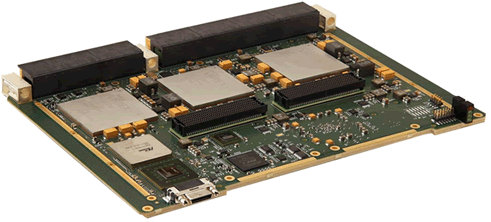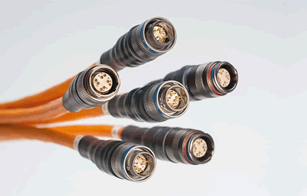10-Gigabit Ethernet Solutions for the Next-Gen Military Platforms
In the early 1970s, a revolutionary architecture known as 1553 Data Bus was introduced. Based on a bussing concept that uses a bus controller to communicate with the various systems, this robust and reliable architecture transfers speeds at 1MHz.
Although still in use today on many avionic platforms and weapons systems, replacement strategies utilizing 10Gb Ethernet (GbE) and the new MIL-DTL-32546 standard, which will eventually include multiple connectors and high-speed protocols such as USB, RJ-45, Fiber Channel, and Gigabit Ethernet through 10GbE capabilities, are starting to emerge.

Phoenix Logistics MIL-DTL-1553 data bus harnesses
Today, both military and civil aircraft designs are being driven by size, weight, and power consumption (SWaP). However, SWaP addresses the overall system in general; it doesn’t go into the specific architecture within the black boxes themselves. So, key industry leaders, including: Boeing, Curtis Wright, and Northrop Grumman, amongst others, collaborated to draft new standards designed to improve the current architecture and address the needs of the defense industry. They decided to focus on a scalable backplane technology, and reached out to several leading connector manufacturers for input on the early development of these high-speed, ruggedized backplane connectors.
These initial development efforts resulted in a faster VME bus standard and a next-generation PCI bus standard for the local bus side. Known as the VPX (VITA 46) computer bus standard.

A VPX board (Source: Curtiss Wright)
VPX architecture provides tremendous levels of scalability, is extremely rugged, and enables reliable high-speed data transfer, and especially so when employed in incredibly complex command, control, communications, computers, intelligence, surveillance, and reconnaissance, or C4ISR, systems.
Interconnect speeds within the military black boxes in use today may require both motherboard-to-daughter card and board-to-board connectors to transfer speeds up to 12Gbps. However, just transferring speeds within the box is simply not effective enough anymore. Box-to-box transfer of information at gigabit speeds is now in high demand, with many environments requiring up to 10Gb Ethernet speeds. This is driving the engineering community towards faster interconnect assemblies, with a goal of achieving reliable, production grade 10GbE solutions.
Other common design demands include: enabling faster information sharing, eliminating bottlenecks, and reducing power consumption, which has resulted in a collaborative effort to work with black box manufacturers on the development and implementation of the ruggedized switches, routers, and processors deployed in digital networks through switched Ethernet links.
A New Electrical Interconnect Systems Approach
To achieve Gigabit Ethernet performance today, the aerospace industry typically uses standard MIL-DTL-38999 Series III type connectors, a Gigabit Ethernet cable (either Cat 5 or Cat 6A), an EMI backshell, and standard terminations, selecting dedicated pin locations for optimum performance. The main issue with this design is that the system is not a true 100Ω impedance design, nor does it isolate the shields. When looking to move to the much faster speeds, such as 10GbE, the current method simply has too many technical issues to overcome.
Studies have shown that the only way to achieve 10GbE performance is to have a true 100Ω dedicated cable assembly. The assembly must utilize a “true” 100Ω impedance connector with shield isolation on the pairs, a Cat 7 cable with the individual shields around each pair, plus an overall gross shield, an EMI backshell that captures all the shields, and a termination length that is very short to minimize the twist loss.

LEMO Cat 6 high-speed harsh environment connectors
These systems must also be reliable, maintainable, and fully repairable, which led the Naval Air Systems Command (NAVAIR) wiring branch and connector manufacturers to develop the new MIL-DTL-32546 military specification, which was published in March of 2016. The mechanical aspects of the connector were written around the popular MIL-DTL-38999 Series III connector, while the electrical parameters were derived from a Telecommunications Industry Association (TIA) Specification for Gigabit Ethernet electrical performance.
Concurrently, the Society of Aerospace Engineers’ SAE AE8-D sub-committee, a working group composed of industry leaders, manufacturers, and end-users, is actively engaged in more committee work. One of the newest standards involves a family of new high-data-rate cables known as AS6070. The AS6070 specification will include several high-speed protocols, including the newest proposed Cat7 cable, capable of 10GbE.
The long-range goal for MIL-DTL-32546 will be to expand its scope to include multiple connectors and high-speed protocols, including: USB, RJ-45, Fiber Channel, and Gigabit Ethernet through 10GbE capabilities.
Design engineers face myriad new challenges when developing increasingly complex military aircraft. The demand for smaller size, lighter weight, and higher density components and systems is driving the new wave of fighters, bombers, UAVs, and attack helicopters, and a key component of all these designs is ever-increasing data transfer speed. While the use of fiber optics continues to rise, the breakthrough in copper cable designs, matched impedance specialty connectors, improved termination methods, and enhanced EMI backshells will provide the industry with two very viable options.
Subscribe to our weekly e-newsletters, follow us on LinkedIn, Twitter, and Facebook, and check out our eBook archives for more applicable, expert-informed connectivity content.
- State of the Industry: 2022-2023 Connector Sales - April 16, 2024
- Amphenol is On a Roll - April 2, 2024
- Nicomatic Proves That Two Heads are Better Than One - March 26, 2024





